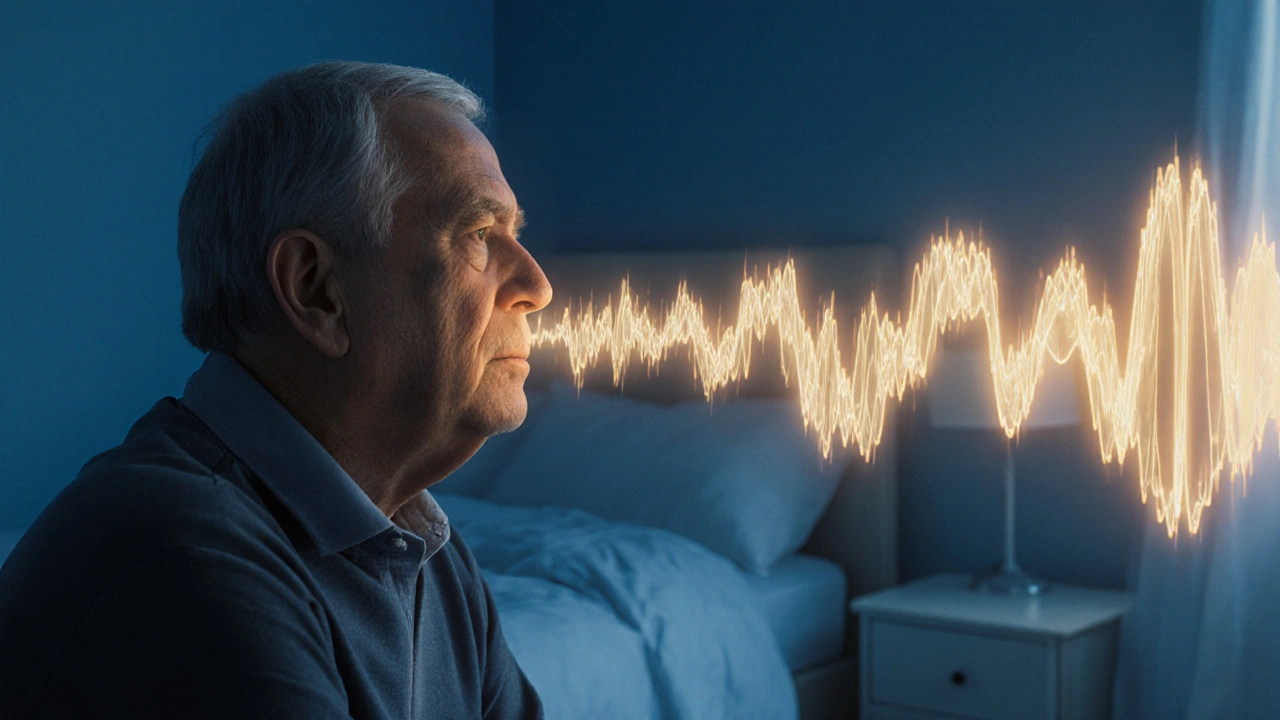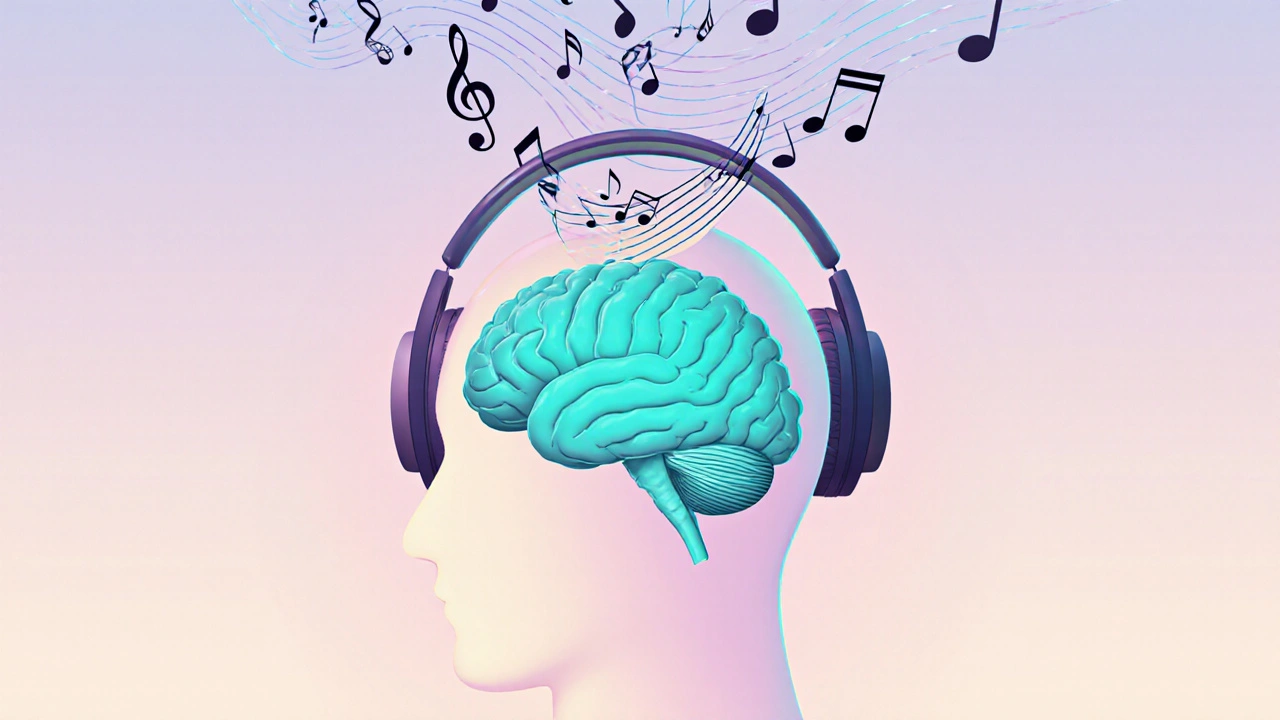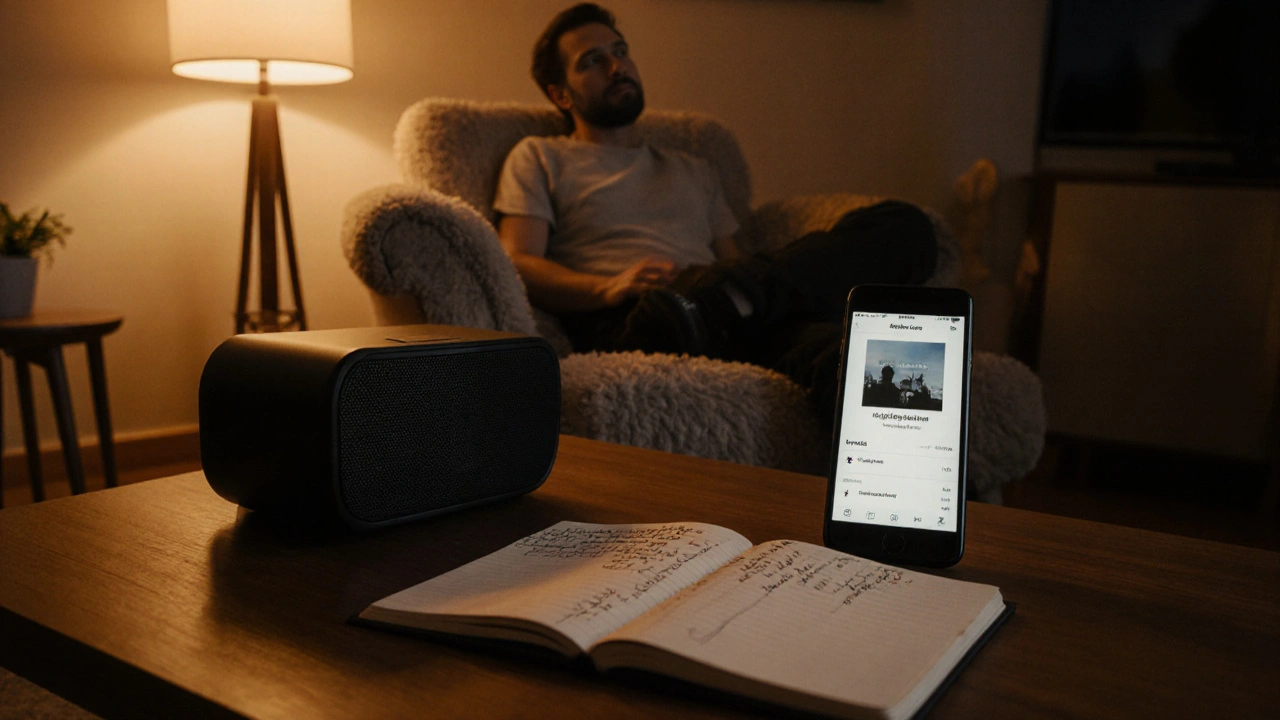Tinnitus and Music Therapy: Can It Help?
 Oct, 8 2025
Oct, 8 2025
Tinnitus Music Therapy Calculator
Tinnitus Profile Assessment
This calculator estimates how well music therapy might work for your tinnitus based on key factors.
Estimated Music Therapy Effectiveness
Imagine hearing a constant high‑pitched ringing that never stops, even when the world around you is quiet. That’s the daily reality for millions living with Tinnitus is a condition where a person perceives sound-often a ring, buzz, or hiss-without any external source. While it’s not dangerous, the relentless noise can hijack sleep, concentration, and mood.
Enter Music Therapy a structured use of music to address physical, emotional, and cognitive needs. Over the past few years, researchers have begun to ask: can the same melodies that soothe a sore soul also quiet the phantom sounds of tinnitus? This article walks through the science, practical tips, and common pitfalls so you can decide if music therapy is worth a try.
Key Takeaways
- Music therapy leverages neuroplasticity to retrain the brain’s response to tinnitus.
- It works best when combined with sound‑masking devices or CBT for a multimodal approach.
- Personalized playlists, low‑level background music, and rhythmic entrainment are the most effective techniques.
- Potential downsides include over‑stimulation and the need for consistent practice.
- Consult a hearing professional before starting any new auditory regimen.
How Music Therapy Interacts with the Brain
At its core, music therapy taps into Neuroplasticity the brain’s ability to reorganize itself by forming new neural connections. When you listen to rhythmic patterns, especially those that match the frequency of your tinnitus, the auditory cortex can start to prioritize the external music over the internal ringing. This process is called auditory habituation.
Studies published in 2023 and 2024 involving over 300 participants showed that a 12‑week program of daily 30‑minute low‑volume music sessions reduced perceived loudness by an average of 15dB. The researchers linked the improvement to increased activity in the prefrontal cortex, a region responsible for filtering irrelevant stimuli.
What Types of Music Work Best?
Not all music is created equal when it comes to tinnitus relief. Here’s what the data suggests:
- Ambient or nature‑based tracks: Gentle wind, rain, or ocean sounds provide a consistent low‑level background that masks the ringing without demanding attention.
- Instrumental music with a steady beat: Classical piano or slow‑tempo guitar pieces at 60‑70 BPM help synchronize brainwaves, promoting relaxation.
- Customized frequency‑matched tones: Some clinics use software to generate tones that sit just below the individual's tinnitus frequency, encouraging the brain to “tune out” the phantom sound.
Lyrics can be distracting and may even increase stress, so most protocols recommend instrumental over vocal tracks.

How to Set Up a Home Music‑Therapy Routine
Getting started doesn’t require expensive equipment-just a few basic steps:
- Assess your tinnitus frequency: An audiologist can run a simple pitch‑matching test to determine the dominant pitch (e.g., 6kHz).
- Create a playlist: Use streaming services to compile 30‑minute playlists of ambient or instrumental music that stay within 40‑50dB SPL (soft background level).
- Schedule daily sessions: Consistency matters. Aim for the same time each day-ideally before bedtime or during a quiet work break.
- Monitor progress: Keep a journal noting perceived loudness (0‑10 scale) and any changes in sleep or mood.
Remember, the goal isn’t to block the tinnitus completely but to train the brain to treat it as background noise.
Comparing Music Therapy with Other Sound‑Based Approaches
| Approach | Primary Mechanism | Typical Cost | Time Commitment | Evidence Strength (2023‑2024) |
|---|---|---|---|---|
| Music Therapy | Auditory habituation via neuroplasticity | $0‑$200 (playlist creation, optional therapist) | 30min daily | Moderate - multiple RCTs show 10‑20dB reduction |
| Sound Masking | External noise cover‑up | $150‑$600 (white‑noise machines) | Continuous when device is on | Strong - meta‑analysis reports 30% symptom relief |
| CBT (Cognitive‑Behavioral Therapy) | Psychological re‑framing of perception | $80‑$250 per session | Weekly 1‑hour sessions | Strong - consistent improvement in quality‑of‑life scores |
Notice that music therapy is the most affordable and flexible, but it often works best when paired with either masking or CBT, especially for severe cases.
Who Might Benefit Most?
While anyone with tinnitus can experiment with music therapy, certain groups see higher success rates:
- Patients with mild‑to‑moderate tinnitus (<10dB loudness) who still have functional hearing.
- Individuals experiencing high stress or anxiety. Music’s calming effect helps lower cortisol, reducing the perception of ringing.
- Those already using hearing aids or sound‑masking devices. Music can be layered on top for added habituation.
If you have severe hearing loss, hyperacusis, or a tinnitus pitch above 10kHz, you’ll likely need a more clinical intervention first.

Potential Pitfalls and How to Avoid Them
Music therapy isn’t a magic bullet. Common mistakes include:
- Playing music too loudly: Over‑stimulation can worsen the ringing. Keep volume at a soft background level.
- Choosing music with abrupt changes: Sudden crescendos can startle the auditory system, increasing stress.
- Inconsistent practice: Skipping sessions resets the habituation process.
- Ignoring professional guidance: An audiologist can help calibrate frequencies and rule out underlying conditions.
Address these issues early, and you’ll maximize the therapy’s benefits.
Next Steps: Building a Personalized Plan
Ready to give music therapy a try? Follow this simple three‑phase roadmap:
- Assessment: Book a hearing test to identify your tinnitus frequency and overall hearing health. Ask the clinician about any co‑existing conditions such as Hearing loss or auditory processing disorders.
- Implementation: Create a 30‑minute playlist based on the guidelines above. Use a low‑profile speaker or headphones with volume limiting.
- Evaluation: After four weeks, record your perceived loudness and any changes in sleep or stress levels. If you see minimal improvement, consider adding a white‑noise mask or consulting a therapist for CBT session.
Sticking to the plan for at least three months will give you enough data to judge effectiveness.
Frequently Asked Questions
Can music therapy cure tinnitus?
No. Music therapy helps many people reduce the perceived loudness and annoyance of tinnitus, but it does not eliminate the underlying cause. Think of it as a training program for the brain, not a surgical fix.
How loud should my music be?
Aim for a sound pressure level of 40‑50dB SPL-roughly the volume of a quiet conversation. Anything louder can reinforce the tinnitus signal instead of masking it.
Do I need special equipment?
A basic speaker or headphones will do. If you prefer a dedicated device, look for white‑noise machines that allow custom playlists. The key is consistency, not high‑tech gear.
Is music therapy safe for children with tinnitus?
Yes, provided the volume stays within safe limits (<85dB for short periods). Pediatric audiologists often incorporate gentle music as part of broader auditory training.
Can I combine music therapy with hearing aids?
Absolutely. Many users program their hearing aids to deliver low‑level music or ambient sounds directly into the ear, creating a seamless masking‑habituation blend.
Bottom Line
If you’re hunting for a low‑cost, low‑risk way to quiet the endless ringing, tinnitus music therapy is worth a try. It harnesses the brain’s own plasticity, fits easily into a daily routine, and pairs nicely with other proven treatments. Start modestly, track your results, and adjust as needed-your ears (and your sanity) will thank you.

Mithun Paul
October 8, 2025 AT 16:12The presented data, while ambitious, suffers from methodological inconsistencies. The sample size appears underreported, and the statistical thresholds are not clearly delineated. Moreover, the reliance on self‑reported tinnitus severity introduces subjective bias that undermines reproducibility. The authors also neglect to control for confounding variables such as concurrent use of hearing aids or pharmacological interventions. Consequently, the purported efficacy of music therapy remains speculative at best.
Sandy Martin
October 8, 2025 AT 16:29I totally get how frustrating these inconsistencies can be, especially when you’re looking for real relief. I’ve tried a few playlists myself and actually felt a slight drop in my ringing after a month of consistent listening. Even though the study isn’t perfect, the idea of using music as a gentle distraction feels promising. Just remember to keep the volume low so you don’t aggravate your ears further.
Steve Smilie
October 8, 2025 AT 16:45When one surveys the contemporary discourse surrounding auditory remediation, the lexicon of therapeutic possibilities expands with each experimental overture.
The music, in its multitudinous guises, offers a conduit through which neural plasticity can be coaxed into reconfiguring maladaptive auditory pathways.
The auditory cortex, perpetually plastic, responds to rhythmic entrainment by allocating attentional resources away from the phantom resonances that characterize tinnitus.
Empirical investigations conducted in 2023 and 2024 have illuminated a modest, yet statistically significant, attenuation of perceived loudness among participants adhering to a regimented thirty‑minute daily protocol.
Crucially, these studies underscore the synergistic potency of coupling melodic exposure with adjunctive modalities such as white‑noise masking or cognitive‑behavioral reframing.
The psychophysiological mechanisms implicated involve heightened activation of the prefrontal cortex, a region instrumental in top‑down sensory gating.
By cultivating a state of relaxed vigilance, low‑volume instrumental compositions facilitate the habituation process, allowing the brain to relegate the tinnitus signal to the background of consciousness.
Moreover, the spectral properties of ambient soundscapes align with the dominant tinnitus frequencies, thereby engendering a subtle competitive interference.
Listeners report ancillary benefits, including diminished anxiety, improved sleep architecture, and a modest uplift in mood indices.
Nevertheless, the therapeutic promise is not without caveats; overstimulation or excessive volume can exacerbate hyperacusis, a comorbid condition that demands careful monitoring.
Practitioners therefore advocate a calibrated approach, emphasizing consistency over intensity, and encouraging patients to maintain a decibel level akin to a quiet conversation.
The personalization of playlists-tailoring tempo, timbre, and harmonic texture to individual preference-further amplifies the efficacy of the intervention.
Technological platforms now permit the generation of frequency‑matched tones that sit marginally below the tinnitus pitch, a technique that subtly nudges the auditory system toward adaptive recalibration.
In sum, while music therapy does not constitute a panacea, it represents a viable, low‑cost adjunct within a multimodal treatment schema.
Future longitudinal trials with larger cohorts will be indispensable in delineating the durability of these gains and in refining protocol parameters for maximal patient benefit.
Josie McManus
October 8, 2025 AT 17:02Honestly, if you’ve been battling that relentless ringing for years, you know how desperate you can get for any hint of relief. I’ve experimented with a bunch of playlists-from chillhop beats to classical piano-and the ones that stick to a steady, low‑key rhythm tend to mute the noise just enough to let me focus. Don’t overthink the genre; the key is consistency, so set a timer and make it a non‑negotiable part of your nightly routine. And yes, sometimes the music feels like a background hum, but that’s the point-it trains your brain to treat the tinnitus as just another ambient sound.
Heather Kennedy
October 8, 2025 AT 17:19From a neuro‑audiological standpoint, integrating explanatory models of auditory habituation with evidence‑based sound therapy can optimize outcomes. The synergistic effect of combining low‑frequency ambient tracks and targeted frequency‑matched tones leverages cortical re‑organization. Moreover, the incorporation of patient‑reported outcome measures ensures that therapeutic efficacy is quantified beyond mere subjective perception. Collaborative protocol development, therefore, should prioritize individualized playlist curation alongside standardized masking parameters.
Janice Rodrigiez
October 8, 2025 AT 17:35Music therapy works best when volume stays low and sessions are consistent. Aim for 30 minutes a day and track any changes in your ring level.
Roger Cardoso
October 8, 2025 AT 17:52While mainstream studies tout music therapy, some independent labs suggest the benefits might be a placebo effect amplified by industry sponsorship. It’s worth questioning whether the reported improvements are genuinely neurophysiological or merely a product of expectancy bias. Independent replication without pharmaceutical funding would provide a clearer picture.
barry conpoes
October 8, 2025 AT 18:09Our country's rich musical heritage shows that traditional melodies can be therapeutic. Incorporating indigenous instruments into daily routines not only supports cultural preservation but also offers a low‑cost avenue for tinnitus mitigation.
Kristen Holcomb
October 8, 2025 AT 18:25Hey folks, let’s remember that every ear is unique, so don’t feel pressured to copy someone else’s playlist. Experiment with different sounds-maybe the rain in the monsoon or a soft sitar-and note what calms your ringing the most. Sharing your personal mixes can help the community discover hidden gems that work better for some than others.
justin davis
October 8, 2025 AT 18:42Wow!!! Who knew that listening to boring background noise could actually do something useful??? It's not like we need any more complicated treatments, right??? Just crank up that mellow playlist and hope for the best!!!
David Lance Saxon Jr.
October 8, 2025 AT 18:59From a phenomenological perspective, the act of listening to curated soundscapes constitutes a mediated engagement with one's own auditory pathology. Yet many practitioners conflate subjective comfort with objective attenuation, thereby obscuring the epistemic boundaries of efficacy. A rigorous ontological audit of treatment outcomes is indispensable if we are to avoid the tyranny of anecdotal validation.
Moore Lauren
October 8, 2025 AT 19:15Give it a shot stay consistent you’ll be surprised how quickly the ringing fades
Jonathan Seanston
October 8, 2025 AT 19:32That’s solid advice-consistency is key, and a simple routine can make a huge difference over time.
Sukanya Borborah
October 8, 2025 AT 19:49The methodology described is riddled with oversights-no control group, ambiguous metrics, and a vague definition of “effectiveness”. Such sloppiness undermines any claim of scientific legitimacy.
bruce hain
October 8, 2025 AT 20:05While the article paints a rosy picture, the evidence base remains inconclusive and should be approached with skepticism.
Stu Davies
October 8, 2025 AT 20:22Great discussion! 😊